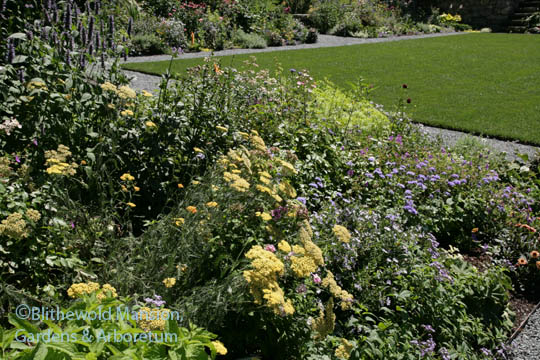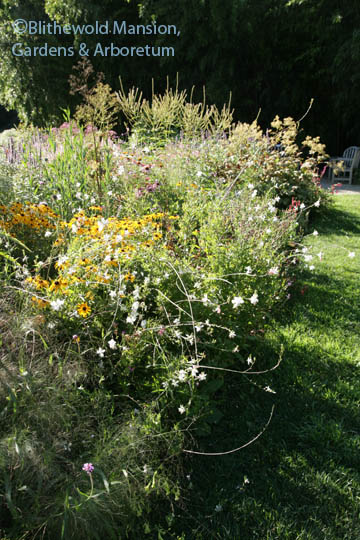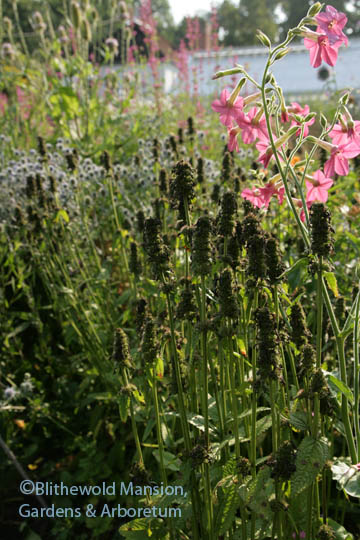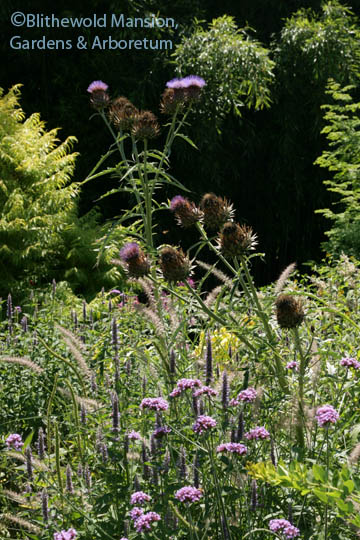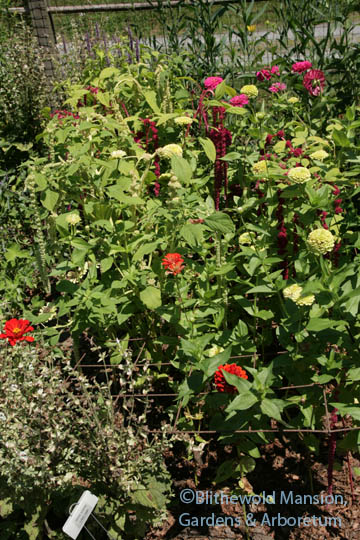What’s at stake
I used to really enjoy the challenge of staking top-heavy plants in such a way that their crutches were as invisible as possible but this year, maybe because the ground is dry enough to make shoving bamboo poles in nearly impossible, I’m kind of over it. I’ve discovered (or maybe rediscovered) an appreciation for plants that still look good when they slouch like lazy teenagers. Some of them, like yarrow have a way of leaning on their neighbors that, from some angles (perhaps not this one – below), doesn’t look like they’re a great crushing weight. I’m also kind of in love with plants that don’t have what I think it was Anna Pavord called “weak ankles.” Agastache ‘Black Adder’ and Stachys officinalis ‘Hummelo’ might be my favorite regimental soldiers ever. And if I can get away with not staking — by cutting something back instead, I will. Any Gaura lindheimeri or nicotiana that flops in the way of the mower is getting offed. No more propping.
 We missed our chance to put peony hoops around the Veronica longifolia in the North Garden so each clump splayed open and leaned like drunks all over the back and middle row. Usually we carefully deadhead that one to prolong its lovely blue spikiness but I’ve taken to whacking most of the stems back to a foot or two in hopes that it will shape up for a sturdier show later. Perhaps next year we’ll add it to the list of plants that need to be lopped in late-spring early summer. I’m all for a slightly later bloom especially if the Coreopsis x ‘Full Moon’ never looked like this again. We did remember to cut back Rudbeckia ‘Henry Eilers’ and Boltonia ‘Nally’s Lime Dot’ and although they’re both already about 5′ tall, at least it doesn’t look like they’re about to fall over. Last year I constructed a web of stakes for the great burnet (Sanguisorba tenuifolia) and this year we smartly moved it back to lean against a fence again, this time in the Cutting Garden.
We missed our chance to put peony hoops around the Veronica longifolia in the North Garden so each clump splayed open and leaned like drunks all over the back and middle row. Usually we carefully deadhead that one to prolong its lovely blue spikiness but I’ve taken to whacking most of the stems back to a foot or two in hopes that it will shape up for a sturdier show later. Perhaps next year we’ll add it to the list of plants that need to be lopped in late-spring early summer. I’m all for a slightly later bloom especially if the Coreopsis x ‘Full Moon’ never looked like this again. We did remember to cut back Rudbeckia ‘Henry Eilers’ and Boltonia ‘Nally’s Lime Dot’ and although they’re both already about 5′ tall, at least it doesn’t look like they’re about to fall over. Last year I constructed a web of stakes for the great burnet (Sanguisorba tenuifolia) and this year we smartly moved it back to lean against a fence again, this time in the Cutting Garden.
So that just leaves the biggies that can’t be encouraged to branch in early summer or cut back now without tremendous sacrifice. I don’t mind if the cardoon lean a little bit but they could fall like trees in a gale. Dahlias too are so brittle that if they flop, they’re down for good, like it or lump it. Sometimes I don’t mind if they fall over because their flowers always manage to face forward but when we’ve planned for their bright shiny faces to show up in the back of a border, they’ve got to stand up straight and that means tying them up to a stake long before the wind blows. And we’re still using concrete reinforcing mesh in the Cutting Garden to hold up zinnias and amaranth and anything else that might topple under its own weight. We lay the grids down on the beds before planting, using the openings as planting guides, and then raise the grids up to provide support as the plants grow. (We really should raise them up early to let the plants grow through them but — call me crazy — I don’t like it when the garden looks like it’s wearing its foundation garments on the outside.)
How and what do you stake – and what do you do to avoid staking?

